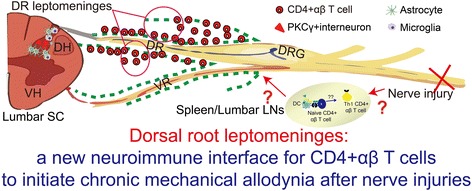Fig. 8.

Schematic model summary for CD4+ αβ T cells to initiate the development of chronic mechanical allodynia after peripheral nerve injuries. After traumatic nerve injuries (partial injuries to the sciatic nerves here), potential unknown autoantigens were present de novo in the cerebrospinal fluid (CSF) compartment at the lumbar vertebral levels and made CD4+ αβ T cells to undergo activation, proliferation, and Th1 inflammatory polarization specifically in the corresponding antigen-draining local lymph nodes (lumbar lymph nodes here) and also in the spleen. For current unknown mechanisms, these antigen-specific and MHC II-restricted CD4+ αβ T cells selectively infiltrate into the DR leptomeninges along the somatosensory pathways transmitting mechanical allodynia. These T cells have an important role in the transition of acute mechanical allodynia to a chronic state and the corresponding glial activation and neuronal sensitization within the gray matter of spinal cord dorsal horns. The direct downstream pathogenic mechanisms for these CD4+ αβ T cells remain unknown. DC dendritic cell, DH dorsal horn, DR dorsal root, DRG dorsal root ganglion, LN lymph node, SC spinal cord, VH ventral horn, VR ventral root
